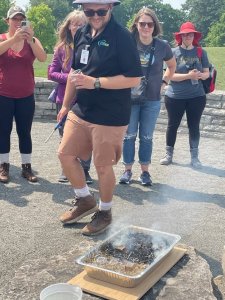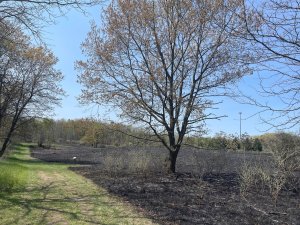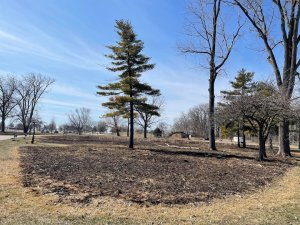The Fiery Fix
February 28, 2024
By: Alexis Olechowski, Interpreter
Fire, often conjuring images of devastation and ruin, embodies a dual nature. While wildfires undoubtedly carry significant risks, especially in the face of climate change, certain ecosystems depend on these flames to maintain their delicate equilibrium. Indeed, wildfires wield the power to both harm and heal native flora and fauna, with specific plant species even relying on fire for their growth and reproduction. So, what delineates a fire’s impact as beneficial or detrimental? Several factors come into play, but let’s begin with the essentials. These fires are classified based on variables such as their ignition source, physical attributes, and meteorological influences. Moreover, the location and carbon emissions of a fire are pivotal factors in assessing its ecological repercussions. Let’s delve deeper into these intricacies.
Wildfires, also known as forest fires, are untamed and capricious blazes that erupt in areas abundant with combustible vegetation. Natural phenomena like lightning strikes, volcanic eruptions, sparks from rock falls, and spontaneous combustions can trigger wildfires without any human intervention.

Interestingly, even wildfires can temporarily foster diverse habitats, providing support to an abundance of diverse species. Throughout history, fires have served as nature’s custodian, clearing away dead vegetation, stimulating seed germination, and fostering the growth of fire-adapted flora. Many plant and animal species in various North American forests have evolved alongside fire, depending on wildfires, particularly those of high severity, for their reproduction and growth. Fire plays a crucial role in returning nutrients from plant matter to the soil, while its heat is indispensable for the germination of specific seeds. The dead trees and early successional forests resulting from high-severity fires create habitat conditions that greatly benefit wildlife. Vegetation follows established patterns of regrowth and change after disturbances. This process of patterned regrowth and change is called plant succession. The rate of succession and the species present at various stages depend on the type and degrees of disturbance, the environment of the sites, and the species available to occupy the site. These early successional forests, born from intense fires, nurture some of the richest levels of native biodiversity in temperate conifer forests. All these are positive outcomes, but what renders natural fires or wildfires detrimental today?
Regrettably, human activities have exacerbated the impact of wildfires, causing twice as many burns than by natural causes alone. While some ecosystems rely on naturally occurring fires to maintain balance, others suffer from excessive fire occurrences, such as the chaparral in southern California and lower-elevation deserts in the American Southwest. The heightened frequency of fires in these ordinarily fire-dependent areas has disrupted natural cycles, harmed native plant communities, and fostered the growth of invasive weeds. Human-induced factors such as climate change, alterations in land use, and firefighting efforts have contributed to the escalation in severity. This predicament creates a troubling cycle, as intensified fires release stored carbon into the atmosphere, exacerbating climate change. Efforts in wildfire prevention aim to mitigate these risks, reducing the severity and spread of fires. Such measures are critical for managing air quality, preserving ecological equilibrium, safeguarding resources, and averting future fire incidents. It’s imperative for prevention strategies to acknowledge human involvement in wildfires, as a significant portion of them are linked to human activities.
Wildfire prevention programs worldwide often employ strategies known as prescribed or controlled burns. These deliberate fires, meticulously orchestrated by fire experts, serve as vital tools for managing ecosystem health and balance across diverse landscapes, including forests, grasslands, and wetlands. In regions like Michigan, prescribed burns fulfill multiple pivotal roles, including invasive species control, enhancement of wildlife habitat, and facilitation of forest and grassland growth, all while mitigating the potential fuel for larger wildfires. By reintroducing fire in a controlled manner, prescribed burns create diverse habitat structures that cater to a wide array of wildlife species without the peril of uncontrollable flames.

So, what sets wildfires apart from prescribed burns? Safety, scale, and timing are critical factors. While wildfires pose a significant threat beyond urban destruction, impacting human health through hazardous emissions, prescribed burns are meticulously planned operations with specific objectives. Exposure to wildfire smoke varies based on factors such as fire severity, duration, and proximity, affecting individuals directly through inhalation and indirectly through soil and water contamination. Fine particulate matter, carbon monoxide, and heavy metals present in wildfire ash pose notable health risks.
Understanding that the intensity and duration of burns greatly influence CO2 emissions is vital. A fast, intense burn may release more CO2 per unit area than a slower, cooler burn. Additionally, the type of vegetation burned influences emissions. Wildfires significantly contribute to the greenhouse effect by releasing substantial amounts of CO2, exacerbating global warming, and potentially leading to more severe wildfires as climate change intensifies. Prescribed burns are carefully managed to minimize CO2 emissions while achieving management objectives such as reducing fuel loads and enhancing ecosystem health. Techniques such as controlled burns during stable atmospheric conditions and promoting fire-resistant vegetation help mitigate emissions. Strategies to enhance carbon sequestration (carbon storage), such as ecosystem restoration, also play a massive role in offsetting CO2 emissions from prescribed burns.
Prescribed burns play a crucial role in carbon sequestration (carbon storage) in Michigan’s ecosystems, particularly those prone to fire. These burns not only reduce the buildup of combustible materials but also control invasive species, promoting the growth of native vegetation while mitigating the risk of uncontrolled wildfires. Restoration efforts across various habitats in Michigan, including forests, grasslands, and wetlands, create diverse structures that store carbon in unique ways. Wetlands serve as crucial carbon banks, vital for carbon storage and biodiversity, as well as regulating water quality. Despite their significance, wetlands face threats from climate change-induced ground fires, which could release substantial carbon emissions. Historically, prescribed fires have been instrumental in promoting wetland vegetation growth and reducing wildfire risks, safeguarding their carbon storage and ecological functions. Grasslands also play a significant role in carbon storage, with temperate grasslands holding more carbon below ground than forests. While grassland fires are common, they have minimal impacts on carbon dioxide emissions. These fires stimulate plant growth and soil bacteria, thereby enhancing carbon sequestration. The restoration of degraded grasslands in Michigan holds immense potential for increasing carbon sequestration, emphasizing the need for effective fire management practices to preserve these vital ecosystems.

Michigan’s diverse ecosystems, including forests, wetlands, and grasslands, provide essential habitats for a wide range of plant and animal species. These ecosystems contribute to overall biodiversity and ecosystem resilience, enhancing their capacity to adapt to environmental changes such as climate change. Prescribed burns not only help maintain the health and diversity of these ecosystems but also contribute to carbon storage by promoting the growth of fire-adapted vegetation and maintaining habitat structures that support a variety of species. By integrating prescribed burns into ecosystem management practices, Michigan can enhance its natural carbon storage capacity while conserving its rich biodiversity and ensuring the long-term resilience of its ecosystems.
In Michigan, prescribed burns hold historical significance, as indigenous communities have employed them for centuries to enhance forest productivity, promote the growth of edible and medicinal plants, and maintain habitats for game animals. Today, prescribed burns are conducted by trained professionals, ensuring effectiveness and safety while preserving the ecological health and resilience of Michigan’s landscapes. These burns embody a harmonious fusion of traditional wisdom and contemporary management practices, underscoring the enduring significance of fire in shaping and sustaining ecosystems.
Interested in reading more? Check out these resources:
https://www.michigan.gov/dnr/managing-resources/forestry/fire/prescribed-fire-explained
https://www.fs.usda.gov/features/professionals-prepare-for-prescribed-burn
https://www.fs.usda.gov/managing-land/fire
